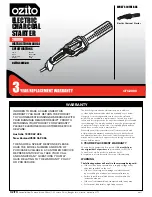
12
|
SEDONA CARE & USE/INSTALLATION
GAS CONNECTIONS...
continued
For
freestanding
units using natural gas, Lynx recommends
using a mobile flex gas line.
This is available at your local hardware store or from your
dealer.
LP GAS
Grills set up for LP gas come equipped with an LP hose/
regulator assembly for connection to a standard 20 lb.
LP cylinder. (Type 1). All fittings necessary to attach the
assembly to the grill are included.
HARD PIPED LP FROM BULK STORAGE TANKS
Permanently plumbed LP connections, such as those in
line with a bulk cylinder, require a 4/11 regulator. (Lynx
P/N 30781)
When using the 4/11 regulator you must ensure that it is
set for the proper fuel type. This is done by removing the
regulator cap and gasket and looking at the bottom of the
plunger to see what fuel type is visible. This is the regulator
fuel setting. NAT is for natural gas and LP is for propane
gas. The LP setting can be further identified by the large
diameter disk on the bottom of the plunger. To change
from one gas to the other simply push the plunger to the
side to snap it out of the cap, turn the plunger so it reads
the desired gas type on the bottom, and push the plunger
until it snaps back into place in the cap then replace the
cap into the regulator.
Never connect an unregulated gas line to the grill.
LP cylinder with type
1 valve connection
DO NOT CHANGE THE REGULATOR/HOSE ASSEMBLY
OR USE ANY OTHER ASSEMBLY THAN THE ONE
SUPPLIED WITH YOUR GRILL.
DO NOT ATTEMPT TO USE A 5LP-A EQUIPPED
REGULATOR/HOSE ASSEMBLY WITH A STANDARD 510
POL CYLINDER/VALVE ASSEMBLY.
DO NOT STORE A SPARE LP-GAS CYLINDER UNDER OR
NEAR THIS APPLIANCE
NEVER FILL THE CYLINDER BEYOND 80 PERCENT FULL.
IF THE INFORMATION ABOVE IS NOT FOLLOWED
EXACTLY, A FIRE CAUSING DEATH OR SERIOUS INJURY
MAY OCCUR.
WARNING
LP Cylinder Requirements
The LP cylinder must be constructed and marked in
accordance with the specifications for LP gas cylinders of
the U.S. Department of Transportation (DOT) and designed
for use with a Type 1 system only.
Cylinders of free
standing grills must be
secured using the
provided cylinder
retention system
to avoid accidental
movement.
When exchanging your cylinder for a refill, exchange only
for a Type 1 20lb cylinder with an over-fill protection device.
Never use a cylinder with a damaged valve.
A dented or rusty LP cylinder may be hazardous and should
be avoided. If in doubt, have it checked by your LP supplier.
Always check for leaks after every LP cylinder change. (See
INDEX: “Leak Test” for further details.)
Always shut off the LP-gas supply at the cylinder when the
grill is not in use.
Cylinders must be stored outdoors in a well-ventilated area
out of the reach of children. If your grill is stored indoors,
the LP cylinder must be stored outside.
Summary of Contents for L500FLP
Page 1: ...MAKE THE MOST OF YOUR CARE USE INSTALLATION...
Page 32: ...32 SEDONA CARE USE INSTALLATION WIRING SCHEMATICS L500 NON ROTISSERIE GRILL...
Page 33: ...SEDONA CARE USE INSTALLATION 33 WIRING SCHEMATICS L500 ROTISSERIE GRILL...
Page 34: ...34 SEDONA CARE USE INSTALLATION WIRING SCHEMATICS L600 L700 NON ROTISSERIE GRILL...
Page 35: ...SEDONA CARE USE INSTALLATION 35 WIRING SCHEMATICS L600 L700 ROTISSERIE GRILL...
Page 36: ...36 SEDONA CARE USE INSTALLATION SEDONA GRILL EXPLODED PARTS VIEW...
Page 37: ...SEDONA CARE USE INSTALLATION 37 SEDONA GRILL PARTS LIST...













































